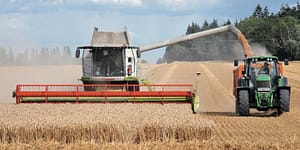Regeneration: The Big Picture

Humans are impacting the environment at a rapid rate, and the Earth can’t keep up to reset the balance. In order to prevent irreversible damage, we must cut carbon emissions. The first step? Understanding the big picture.
The following is an excerpt from Grassroots Rising by Ronnie Cummins. It has been adapted for the web.
Let’s just start off with the big picture and try to make the math and the science as simple as possible.
Humans are emitting the equivalent of ten billion tons of carbon every year through burning fossil fuels and destructive agricultural and land use practices. These ten billion tons are going up into the already carbonsupersaturated atmosphere and into the oceans, heating up the average temperature on the planet and pushing us closer and closer to runaway global warming and climate catastrophe.
If we want to avoid climate chaos and survive, we the global grassroots must rise up and put an end to business as usual over the next decade and beyond. We must cut global emissions of carbon and other greenhouse gases (GHG) by approximately five billion tons, or 50 percent, over the next decade. At the same time, we must simultaneously start to draw down billions of tons of atmospheric carbon every year through regenerative food, farming, and land use practices, sequestering it in our soils, forests, and plants, reaching at least five billion tons of global carbon drawdown by 2030. This will bring us to net zero emissions by 2030, which is basically the bottom line for human survival.
For the next several decades beyond 2030, we must continue to draw down and sequester in our soils, forest, and plants approximately five to twenty billion tons of carbon per year, while producing little to no fossil fuel emissions whatsoever.
This will move us away from our current trajectory of climate catastrophe and put us on the regenerative path of restabilizing the climate and bringing atmospheric CO2 back to the safe levels that existed before the industrial revolution began around 1750. Different scientists define the “safe” level of CO2 in the atmosphere as either 350 ppm, 300 ppm, or 280 ppm, but everyone agrees that the most desirable level to avert climate disaster would be 280 ppm.
For reference purposes in this book, 1 ton of solid carbon is equal in weight to 3.67 tons of CO2 gas, while CO2e refers to all greenhouse gases including methane and nitrous oxide. CO2e is often referred to as the “carbon footprint” of burning fuels or releasing greenhouse gases through land disturbance or deforestation.
One part per million (1 ppm) of CO2 in the atmosphere is equal to 7.8 gigatons (Gt or billion tons) of CO2 or 2.125 Gt of solid carbon. Global atmospheric concentrations of CO2 reached 415 ppm in 2018, the highest level in millions of years, whereas safe levels are considered to be 280 to 350 ppm, the range that has existed since humans appeared on the planet.
Recommended Reads
Recent Articles
Why is modern wheat making us sick? That’s the question posed by author Eli Rogosa in Restoring Heritage Grains. Wheat is the most widely grown crop on our planet, yet industrial breeders have transformed this ancient staff of life into a commodity of yield and profit—witness the increase in gluten intolerance and ‘wheat belly’. Modern…
Read MoreAddressing the pressing issues affecting everyday Americans is essential—and one of our nation’s most profound challenges is the devastating impact of mass layoffs. Layoffs upend people’s lives, cause enormous stress, and lead to debilitating personal debt. The societal harm caused by mass layoffs has been known for decades. Yet, we do little to stop them.…
Read MoreWhat does facing the beast mean? In this time of uncertainty, we must practice regular reflection to achieve optimal happiness and health. The metaphor below gives insight into confronting and facing it, regardless of what “the beast” is to you. The following is. an excerpt from Facing the Beast by Naomi Wolf. It has been adapted for the…
Read MoreWe’ve all heard of the phrases “time flies” and “time heals all wounds,” but what really is time, and how does it impact our lives? The concept of time may be even more powerful than we think, especially when it comes to the money we save and spend. The following is an excerpt from The…
Read More“Climate change asks us questions that climate science cannot answer,” — Dougald Hine When it comes to climate change, it seems as if there are always new questions arising: How did we get to this point? How can we stop it? What’s next? Unfortunately, there is no black-and-white, straightforward answer to any of them —…
Read More








